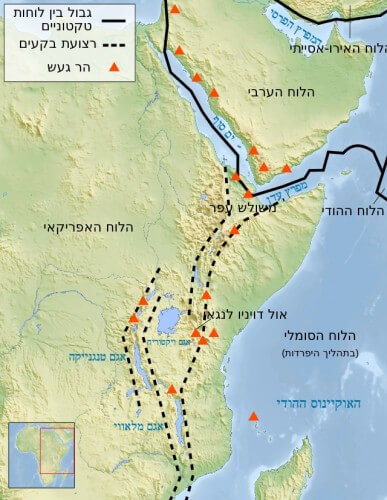Gases from ancient times confirm the cause of the continental rift

Africa splits in two. The reason: a geological fault that stretches along the east of the continent. One day, in millions of years, there will be an ocean in place of this fissure. Scientists have been arguing for years about the cause of the separation of these tectonic plates. Geophysicists believed that the cause was a superplume, a huge mass of the Earth's mantle that conducts heat from areas near the Earth's core up into the crust. As evidence, they point to two large plateaus (one in Ethiopia and the other in Kenya) which they say were created when the super-convex pushed the mantle up. Geochemists were not able to confirm this theory, and believed that the cause is actually two separate, smaller changes, each protruding one level. The theories disagreed, says David Hilton, a geochemist at the Scripps Institution of Oceanography in La Jolla, California. "There was a mismatch between chemistry and physics. "
Hilton therefore went to East Africa in 2006 and 2011 to try to settle the argument once and for all. He and his men decided to use the gases emitted from the fissure to determine how it was formed. They put on gas masks and climbed to the summits of volcanoes in Tanzania and Ethiopia, and descended into mazuku ("evil spirit" in Swahili), geothermal shafts and sinkholes where toxic gases accumulate that often kill animals. There they collected samples of rocks formed in eruptions, including olivine, a crystalline mineral that traps volcanic gases like in a bottle.
In a laboratory in California, Hilton crushed the rocks in a vacuum chamber to release the gases from them. He was looking for helium 3, an isotope of helium that was common when the Earth was formed, and remains trapped in our shells. Hilton hypothesized that if both the Ethiopian and Kenyan Plateau rocks contain this primordial gas, this would at least support the theory that subterranean changes in the mantle created them. And he did find helium 3 at both levels. But Hilton and his colleagues still had to answer the question: Is a single superdome behind it all, or two smaller ones?
To answer this question, they tested another primordial gas preserved in the Earth's mantle: neon 22. They found neon 22 in both levels and found that the ratio between the amounts of helium and neon in both regions was equal. The results were published in the April 2014 issue of the journal Geophysical Research Letters. The meaning of the measurements is that the transformations below the two levels are made of the same materials and of the same age. Therefore, it was concluded that there is one common super-transmitter. The geophysicists were therefore right all along.
"The 'skeptics' who claimed that there was no connection between the activity of the fissure and the operation of the Tamra, and some of them who even denied the existence of the Tamra at the site, have lost any basis for their claims," says Pete Bernard, a geochemist from France's National Institute for Scientific Research, who was not involved in the latest study.
The African Super Tamarind will provide scientists with easier access to study the inner workings of the Earth (there is another Tamarind under the Pacific Ocean). Hilton and his people are now measuring how much carbon the mantle is releasing in East Africa, trying to determine the age of this carbon and checking if it is a product of a carbon cycle that was assimilated on the ground billions of years ago. This information, Hilton says, will help geologists understand the interrelationships between the different layers of the earth over longer periods of time, including the order of magnitude of hundreds of millions of years, which is the time it takes for continents to form and split apart.

2 תגובות
There is something annoying Nora in all this silence around the fact that there are areas in the country
That they will literally break up into small islands with people in general and areas that will still according to the geological forecast "exist". How hard can it be to predict that?
And why is there such silence and only now are we writing a little about the subject after an earthquake in Be'er Sheva and the surrounding area...
There is and there is. We must prophesy it for the sake of Klal Yisrael.
I did not understand